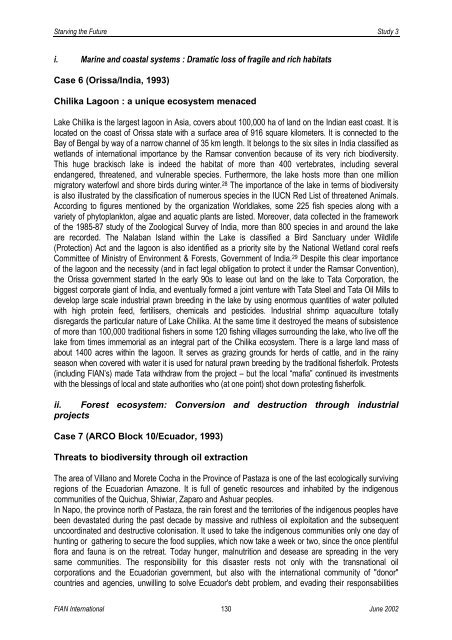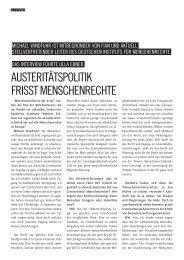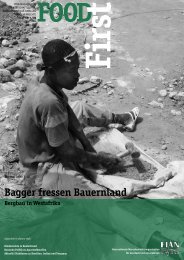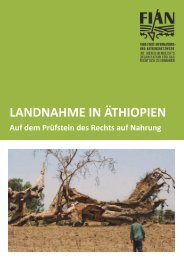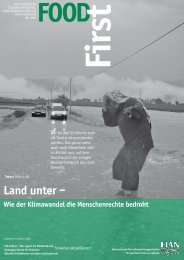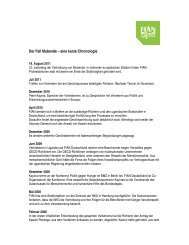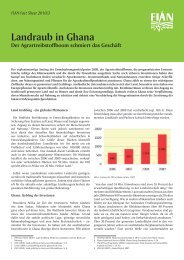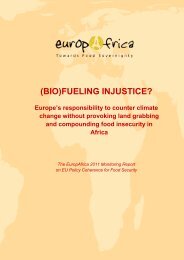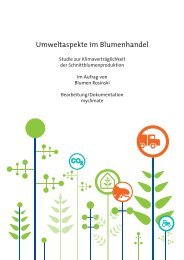Study 3: Ecodestruction and the Right to Food: The Cases of Water ...
Study 3: Ecodestruction and the Right to Food: The Cases of Water ...
Study 3: Ecodestruction and the Right to Food: The Cases of Water ...
Create successful ePaper yourself
Turn your PDF publications into a flip-book with our unique Google optimized e-Paper software.
Starving <strong>the</strong> Future <strong>Study</strong> 3<br />
i. Marine <strong>and</strong> coastal systems : Dramatic loss <strong>of</strong> fragile <strong>and</strong> rich habitats<br />
Case 6 (Orissa/India, 1993)<br />
Chilika Lagoon : a unique ecosystem menaced<br />
Lake Chilika is <strong>the</strong> largest lagoon in Asia, covers about 100,000 ha <strong>of</strong> l<strong>and</strong> on <strong>the</strong> Indian east coast. It is<br />
located on <strong>the</strong> coast <strong>of</strong> Orissa state with a surface area <strong>of</strong> 916 square kilometers. It is connected <strong>to</strong> <strong>the</strong><br />
Bay <strong>of</strong> Bengal by way <strong>of</strong> a narrow channel <strong>of</strong> 35 km length. It belongs <strong>to</strong> <strong>the</strong> six sites in India classified as<br />
wetl<strong>and</strong>s <strong>of</strong> international importance by <strong>the</strong> Ramsar convention because <strong>of</strong> its very rich biodiversity.<br />
This huge brackisch lake is indeed <strong>the</strong> habitat <strong>of</strong> more than 400 vertebrates, including several<br />
endangered, threatened, <strong>and</strong> vulnerable species. Fur<strong>the</strong>rmore, <strong>the</strong> lake hosts more than one million<br />
migra<strong>to</strong>ry waterfowl <strong>and</strong> shore birds during winter. 28 <strong>The</strong> importance <strong>of</strong> <strong>the</strong> lake in terms <strong>of</strong> biodiversity<br />
is also illustrated by <strong>the</strong> classification <strong>of</strong> numerous species in <strong>the</strong> IUCN Red List <strong>of</strong> threatened Animals.<br />
According <strong>to</strong> figures mentioned by <strong>the</strong> organization Worldlakes, some 225 fish species along with a<br />
variety <strong>of</strong> phy<strong>to</strong>plank<strong>to</strong>n, algae <strong>and</strong> aquatic plants are listed. Moreover, data collected in <strong>the</strong> framework<br />
<strong>of</strong> <strong>the</strong> 1985-87 study <strong>of</strong> <strong>the</strong> Zoological Survey <strong>of</strong> India, more than 800 species in <strong>and</strong> around <strong>the</strong> lake<br />
are recorded. <strong>The</strong> Nalaban Isl<strong>and</strong> within <strong>the</strong> Lake is classified a Bird Sanctuary under Wildlife<br />
(Protection) Act <strong>and</strong> <strong>the</strong> lagoon is also identified as a priority site by <strong>the</strong> National Wetl<strong>and</strong> coral reefs<br />
Committee <strong>of</strong> Ministry <strong>of</strong> Environment & Forests, Government <strong>of</strong> India. 29 Despite this clear importance<br />
<strong>of</strong> <strong>the</strong> lagoon <strong>and</strong> <strong>the</strong> necessity (<strong>and</strong> in fact legal obligation <strong>to</strong> protect it under <strong>the</strong> Ramsar Convention),<br />
<strong>the</strong> Orissa government started In <strong>the</strong> early 90s <strong>to</strong> lease out l<strong>and</strong> on <strong>the</strong> lake <strong>to</strong> Tata Corporation, <strong>the</strong><br />
biggest corporate giant <strong>of</strong> India, <strong>and</strong> eventually formed a joint venture with Tata Steel <strong>and</strong> Tata Oil Mills <strong>to</strong><br />
develop large scale industrial prawn breeding in <strong>the</strong> lake by using enormous quantities <strong>of</strong> water polluted<br />
with high protein feed, fertilisers, chemicals <strong>and</strong> pesticides. Industrial shrimp aquaculture <strong>to</strong>tally<br />
disregards <strong>the</strong> particular nature <strong>of</strong> Lake Chilika. At <strong>the</strong> same time it destroyed <strong>the</strong> means <strong>of</strong> subsistence<br />
<strong>of</strong> more than 100,000 traditional fishers in some 120 fishing villages surrounding <strong>the</strong> lake, who live <strong>of</strong>f <strong>the</strong><br />
lake from times immemorial as an integral part <strong>of</strong> <strong>the</strong> Chilika ecosystem. <strong>The</strong>re is a large l<strong>and</strong> mass <strong>of</strong><br />
about 1400 acres within <strong>the</strong> lagoon. It serves as grazing grounds for herds <strong>of</strong> cattle, <strong>and</strong> in <strong>the</strong> rainy<br />
season when covered with water it is used for natural prawn breeding by <strong>the</strong> traditional fisherfolk. Protests<br />
(including FIAN’s) made Tata withdraw from <strong>the</strong> project – but <strong>the</strong> local “mafia” continued its investments<br />
with <strong>the</strong> blessings <strong>of</strong> local <strong>and</strong> state authorities who (at one point) shot down protesting fisherfolk.<br />
ii. Forest ecosystem: Conversion <strong>and</strong> destruction through industrial<br />
projects<br />
Case 7 (ARCO Block 10/Ecuador, 1993)<br />
Threats <strong>to</strong> biodiversity through oil extraction<br />
<strong>The</strong> area <strong>of</strong> Villano <strong>and</strong> Morete Cocha in <strong>the</strong> Province <strong>of</strong> Pastaza is one <strong>of</strong> <strong>the</strong> last ecologically surviving<br />
regions <strong>of</strong> <strong>the</strong> Ecuadorian Amazone. It is full <strong>of</strong> genetic resources <strong>and</strong> inhabited by <strong>the</strong> indigenous<br />
communities <strong>of</strong> <strong>the</strong> Quichua, Shiwiar, Zaparo <strong>and</strong> Ashuar peoples.<br />
In Napo, <strong>the</strong> province north <strong>of</strong> Pastaza, <strong>the</strong> rain forest <strong>and</strong> <strong>the</strong> terri<strong>to</strong>ries <strong>of</strong> <strong>the</strong> indigenous peoples have<br />
been devastated during <strong>the</strong> past decade by massive <strong>and</strong> ruthless oil exploitation <strong>and</strong> <strong>the</strong> subsequent<br />
uncoordinated <strong>and</strong> destructive colonisation. It used <strong>to</strong> take <strong>the</strong> indigenous communities only one day <strong>of</strong><br />
hunting or ga<strong>the</strong>ring <strong>to</strong> secure <strong>the</strong> food supplies, which now take a week or two, since <strong>the</strong> once plentiful<br />
flora <strong>and</strong> fauna is on <strong>the</strong> retreat. Today hunger, malnutrition <strong>and</strong> desease are spreading in <strong>the</strong> very<br />
same communities. <strong>The</strong> responsibility for this disaster rests not only with <strong>the</strong> transnational oil<br />
corporations <strong>and</strong> <strong>the</strong> Ecuadorian government, but also with <strong>the</strong> international community <strong>of</strong> "donor"<br />
countries <strong>and</strong> agencies, unwilling <strong>to</strong> solve Ecuador's debt problem, <strong>and</strong> evading <strong>the</strong>ir responsabilities<br />
FIAN International 130<br />
June 2002


